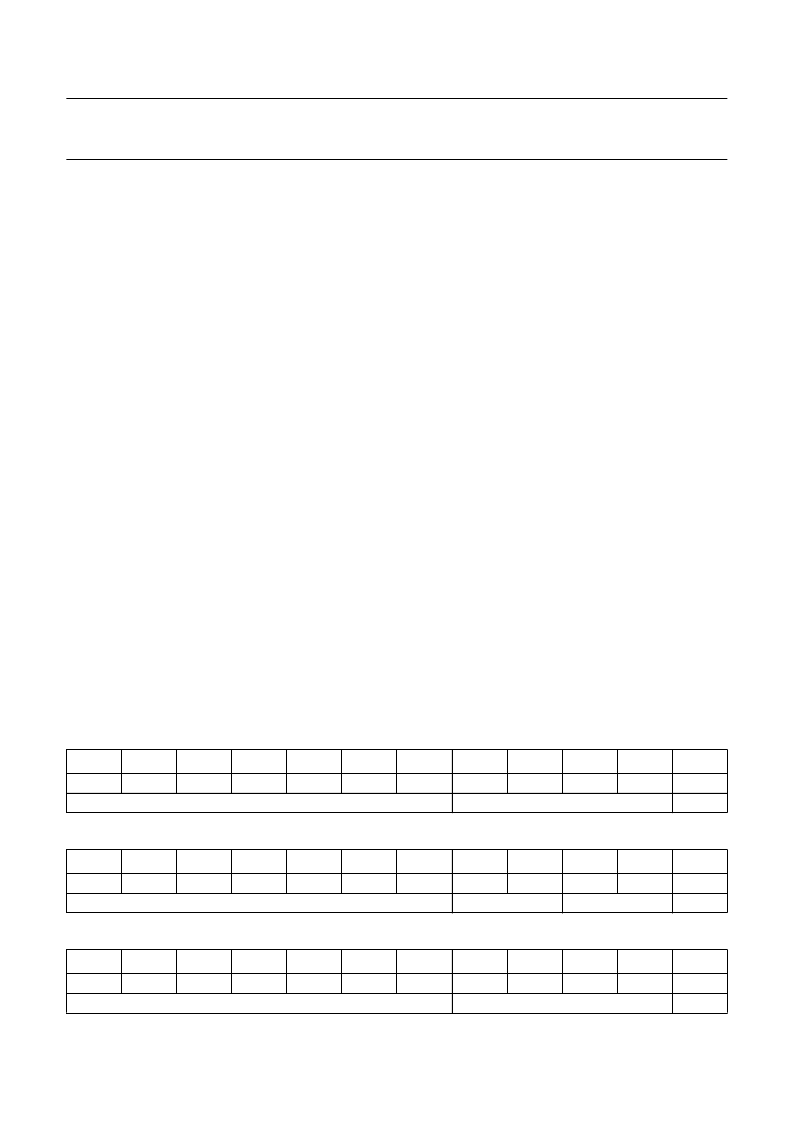- 您現(xiàn)在的位置:買賣IC網(wǎng) > PDF目錄382378 > PCA8514P (NXP Semiconductors N.V.) Stand-alone OSD PDF資料下載
參數(shù)資料
| 型號(hào): | PCA8514P |
| 廠商: | NXP Semiconductors N.V. |
| 英文描述: | Stand-alone OSD |
| 中文描述: | 單機(jī)OSD |
| 文件頁(yè)數(shù): | 11/64頁(yè) |
| 文件大?。?/td> | 322K |
| 代理商: | PCA8514P |
第1頁(yè)第2頁(yè)第3頁(yè)第4頁(yè)第5頁(yè)第6頁(yè)第7頁(yè)第8頁(yè)第9頁(yè)第10頁(yè)當(dāng)前第11頁(yè)第12頁(yè)第13頁(yè)第14頁(yè)第15頁(yè)第16頁(yè)第17頁(yè)第18頁(yè)第19頁(yè)第20頁(yè)第21頁(yè)第22頁(yè)第23頁(yè)第24頁(yè)第25頁(yè)第26頁(yè)第27頁(yè)第28頁(yè)第29頁(yè)第30頁(yè)第31頁(yè)第32頁(yè)第33頁(yè)第34頁(yè)第35頁(yè)第36頁(yè)第37頁(yè)第38頁(yè)第39頁(yè)第40頁(yè)第41頁(yè)第42頁(yè)第43頁(yè)第44頁(yè)第45頁(yè)第46頁(yè)第47頁(yè)第48頁(yè)第49頁(yè)第50頁(yè)第51頁(yè)第52頁(yè)第53頁(yè)第54頁(yè)第55頁(yè)第56頁(yè)第57頁(yè)第58頁(yè)第59頁(yè)第60頁(yè)第61頁(yè)第62頁(yè)第63頁(yè)第64頁(yè)

1995 Nov 27
11
Philips Semiconductors
Product specification
Stand-alone OSD
PCA8514
8
DISPLAY RAM ORGANIZATION
The display RAM is organized as 256
×
12 bits. The
general format of each RAM location is as follows.
Bits <11-5> hold character data and allow a choice from
125 customer designed character fonts to be selected or
one of three reserved codes. Bits <4-0> contain the
attributes of the character font, for example colour,
character size etc.
8.1
Description of display RAM codes
There are four data formats for display RAM code:
1.
Character Font Code
2.
Test Code
3.
Carriage Return Code
4.
Space Code.
The above data formats allow great flexibility in the
creation of On Screen Displays; see Fig.8.
8.1.1
C
HARACTER FONT CODE
If bits <11-5> are in the range (00H to 7CH), then this is a
Character Font Code. 1 of 125 customer designed
character fonts can be selected. Bits <4-1> determine the
colour of the character, a choice of 16 colours being
available. Bit <0> determines whether the character blinks
or not. The format of the Character Font Code is shown in
Table 2.
8.1.2
T
EST CODE
If bits <11-5> hold 7DH, then this is a special code
reserved for testing purposes only.
8.1.3
C
ARRIAGE RETURN CODE
If bits <11-5> hold 7EH, then this is the Carriage Return
Code. A transparent pattern will be displayed on the
screen and the next character will be displayed at the
beginning of the next line. Bits <4-3> select the size of the
characters to be displayed on the next line. Bits <2-1>
determine the spacing between lines of displayed
characters. Bit <0> is the End of Display bit and indicates
the end of display of the current screen before exhaustion
of display RAM (i.e. before the 256th RAM location). The
format of the Carriage Return Code is shown in Table 3.
8.1.4
S
PACE CODE
If bits <11-5> hold 7FH, then this is the Space Code.
A transparent pattern, equal to one character width, will be
displayed on the screen. A mask programmable option is
available that allows the space character to be transparent
or to have a programmable background colour;
see Section 13.1. Bits <4-1> determine the background
colour of the characters that follow the Space Code in both
the Box shadowing and North-West shadowing modes.
Bit <0> is the Active Character Monitor (ACM)
enable/disable bit. The ACM signal is specifically for use in
camrecorder applications where part of the display is to be
recorded on tape and displayed on the screen, whilst the
remaining part is for display only. Figure 9 shows a typical
ACM application. During the back-tracing period R, G, B, I,
FB and ACM are inactive. The format of the Space Code
is shown in Table 4.
Table 2
Format of Character Font Code
Table 3
Format of Carriage Return Code
Table 4
Format of Space Code
11
10
9
8
7
6
5
4
3
2
1
0
C6
C5
C4
C3
C2
C1
C0
T4
T3
T2
T1
T0
Blink
Character Font Code (00H - 7CH)
Foreground colour
11
10
9
8
7
6
5
4
3
2
1
0
C6
C5
C4
C3
C2
C1
C0
T4
Character size
T3
T2
Line Spacing
T1
T1
End
Carriage Return Code (7EH)
11
10
9
8
7
6
5
4
3
2
1
0
C6
C5
C4
C3
C2
C1
C0
T4
T3
T2
T1
T0
ACM
Space Code (7FH)
Background colour
相關(guān)PDF資料 |
PDF描述 |
|---|---|
| PCA8514T | Stand-alone OSD |
| PCA8515 | Stand-alone OSD |
| PCA8515P | Stand-alone OSD |
| PCA8515T | Stand-alone OSD |
| PCA8516T | Stand-alone OSD |
相關(guān)代理商/技術(shù)參數(shù) |
參數(shù)描述 |
|---|---|
| PCA8514T | 制造商:PHILIPS 制造商全稱:NXP Semiconductors 功能描述:Stand-alone OSD |
| PCA8515 | 制造商:PHILIPS 制造商全稱:NXP Semiconductors 功能描述:Stand-alone OSD |
| PCA8515P | 制造商:PHILIPS 制造商全稱:NXP Semiconductors 功能描述:Stand-alone OSD |
| PCA8515T | 制造商:PHILIPS 制造商全稱:NXP Semiconductors 功能描述:Stand-alone OSD |
| PCA8515T/009 | 制造商:NXP Semiconductors 功能描述:ON-SCREEN DISPLAY IC, PDSO24 |
發(fā)布緊急采購(gòu),3分鐘左右您將得到回復(fù)。